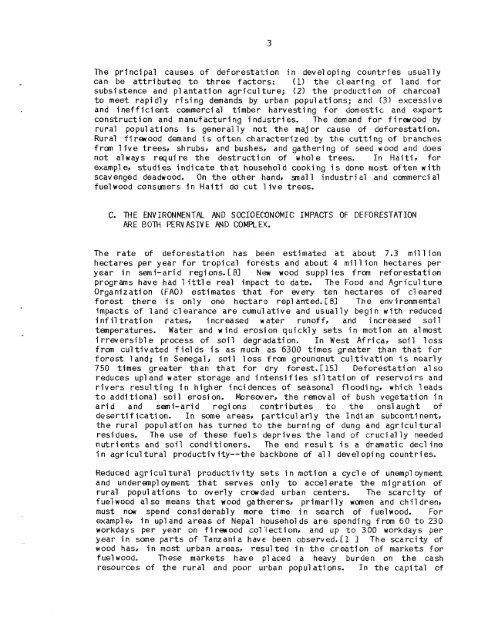Prospects for Coal Briquettes as a Substitute Fuel for Wood and ...
Prospects for Coal Briquettes as a Substitute Fuel for Wood and ...
Prospects for Coal Briquettes as a Substitute Fuel for Wood and ...
Create successful ePaper yourself
Turn your PDF publications into a flip-book with our unique Google optimized e-Paper software.
3<br />
The priincipal causes of de<strong>for</strong>estatdon in developing countrjes usual 7y<br />
can be attributed to three factors: (1) the clearing of l<strong>and</strong> <strong>for</strong><br />
subsistence <strong>and</strong> pl antatian agriculture; (2) the production of charcoal<br />
to meet rapidly rising dem<strong>and</strong>s by urban populations; <strong>and</strong> (3) excesslve<br />
<strong>and</strong> inefficient commerci a1 timber harvssti ng <strong>for</strong> domestic <strong>and</strong> export<br />
construction <strong>and</strong> manufacturing IndJstries. The dem<strong>and</strong> <strong>for</strong> fisewoood by<br />
rural populations is generally not the maJw cause of de<strong>for</strong>estation.<br />
Rural firewood dem<strong>and</strong> is often characterized by the cuttfng of branches<br />
from live trees, shrubsr <strong>and</strong> bushesI <strong>and</strong> gathering of seed wood <strong>and</strong> does<br />
not always require the destruction of whole trees. In HaitSr <strong>for</strong><br />
exampl er studies indicate that househol d caoki ng is done most often with<br />
scavenged deadwood, On the other h<strong>and</strong>, mal 1 industri a1 <strong>and</strong> cmmerci al<br />
fuelwood consumer^ in Haiti do cut 1 ive trees.<br />
C, THE ENVIRONMENTAL PND S0CIOEC:ONQMIC IMPACTS OF DEFORESTATION<br />
ARE BOTH PERVASIVE MD CQIU(PLEY.<br />
The rate of de<strong>for</strong>estation h<strong>as</strong> been esttmated at about 7.3 rnilll’an<br />
hectares per year <strong>for</strong> tropical <strong>for</strong><strong>as</strong>ts <strong>and</strong> about 4 mill ion hectares per<br />
year in semi-arid regions.C81 New wood suppl ies frm re<strong>for</strong>estation<br />
programs have had 1 ittle real impact to date. The Food <strong>and</strong> Agriculture<br />
Organization (FA01 estimates that <strong>for</strong> every ten hectares of cl eared<br />
<strong>for</strong>est there is only one hectar.9 reg1 anted, C 63 The environmental<br />
impacts of l<strong>and</strong> clearance are cumulative <strong>and</strong> usually begin with reduced<br />
i nf il trati on ratesl incre<strong>as</strong>ed w ater runof fl <strong>and</strong> i ncre<strong>as</strong>ed soi 1<br />
temperatures. Water <strong>and</strong> w ind erosion quickly sets In motion an al most<br />
Irreversible process of soil degradation. In West Africap soil loss<br />
from cultivated fields is <strong>as</strong> much <strong>as</strong> 6300 times greater than that <strong>for</strong><br />
<strong>for</strong>est l<strong>and</strong>; in Senegal8 soil loss from grounanut cultivation is nearly<br />
750 times greater than that <strong>for</strong> dry <strong>for</strong>est.LJ.51 De<strong>for</strong>estation also<br />
reduces up1 <strong>and</strong> water storage <strong>and</strong> Intensifies sll tati on of reservoi rs <strong>and</strong><br />
rivers resultfng in higher fncidences of se<strong>as</strong>onal flooding, whr”ch leads<br />
to additional soil erosion. Mareoverl the removal af bush vegetation in<br />
arid <strong>and</strong> semi-arid regions contributes to the onslaught of<br />
deserti f icati on. In some are<strong>as</strong>8 particul arl y the Indi an subcontl nent,<br />
the rural population h<strong>as</strong> turned to the burning of‘ dung <strong>and</strong> agricultural<br />
residues, The use of these fuels deprives the l<strong>and</strong> of crucially needed<br />
nutrients <strong>and</strong> soil condittoners. The end result is a dramatic decline<br />
in agricul tural product-ivity--the backbone of a1 1 devel oping countries.<br />
Reduced agrdcul tural productivity sets i n motion a cycl e of unempl oyment<br />
<strong>and</strong> underemployment that serves only to accelerate the mlgrall’an of<br />
rural populations to overly crwdad urban centers. The scarclty of<br />
fuel wood al so means that wood gatherersr primarily wmen <strong>and</strong> chS1 dt-en,<br />
must now spend consdderably more time in search of feaelwaod, For<br />
exampl el in up3 <strong>and</strong> are<strong>as</strong> of Nepal househol ds are spendfng fr<br />
workdays per year on firewood col‘~lec-tian, <strong>and</strong> up to 300 workdays pes<br />
year l”n some parts of Tanzania hay& been abserved.Cl 1 The scarcity of<br />
wood h<strong>as</strong>r in most urban are<strong>as</strong>s resulted in the creation of markets <strong>for</strong><br />
fuelwood. These markets have placed a heavy burden on the c<strong>as</strong>h<br />
resources of the rural <strong>and</strong> poor urban populations. In the capital of

















